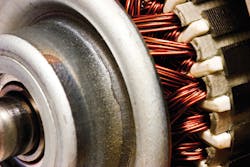Replacing a standard industrial motor with an energy-efficient version is a great way to reduce energy loss. But it’s hard to justify doing this if that standard motor is running just fine. So what can you do?
First, understand that an energy-efficient design is basically just a better design. There’s no special magic to it. It does cost more to build, thus it carries a higher price. The difference pays for itself many times over, both in less energy use and in higher reliability.
The motor itself will consume less energy than a standard motor, but it does not by itself solve all energy waste problems with the installation. Whether you have a motor with an energy-efficient design or not, take these steps:
• Have a Level II or higher thermographer conduct a thermographic analysis with special attention to the bearings. If the bearings run hot, they may be the wrong bearings for the application or they may have the wrong lubricant; consult a motor repair shop for advice.
• Use a power analyzer on the supply. Look for (and correct) excessive 3rd or 5th harmonics, low power factor (at the motor), voltage imbalance, and wave distortion. Correcting wave distortion can be complicated; you may need to hire a power quality consultant.
• Ensure all metallic surfaces are bonded. See the Art. 100 definitions of bonding and grounding in the National Electrical Code (NEC); do not confuse the two. How can this possibly matter for energy waste? If you’ve got undesired current using the motor as a return path, the motor will run hotter. Granted, a more compelling reason is that current destroys the bearings. And the most compelling reason is the situation is unsafe. But it also wastes energy.
• Run vibration analysis on the motor. Use a higher-end analyzer, so that you get additional information that the entry-level units do not provide. When a motor is vibrating, what is really happening is some of its motive force that takes electricity to produce is moving the motor instead of the load. You want to reduce vibration as much as is practical to do. That could entail several measures, including replacing the motor foundation and pedestal with far stiffer versions.
If your company has embraced “green,” then you can justify these improvements based on energy savings. If you don’t have that advantage, you can easily enough justify these improvements based on downtime reduction. Either way, they are well worth doing.
About the Author

Mark Lamendola
Mark is an expert in maintenance management, having racked up an impressive track record during his time working in the field. He also has extensive knowledge of, and practical expertise with, the National Electrical Code (NEC). Through his consulting business, he provides articles and training materials on electrical topics, specializing in making difficult subjects easy to understand and focusing on the practical aspects of electrical work.
Prior to starting his own business, Mark served as the Technical Editor on EC&M for six years, worked three years in nuclear maintenance, six years as a contract project engineer/project manager, three years as a systems engineer, and three years in plant maintenance management.
Mark earned an AAS degree from Rock Valley College, a BSEET from Columbia Pacific University, and an MBA from Lake Erie College. He’s also completed several related certifications over the years and even was formerly licensed as a Master Electrician. He is a Senior Member of the IEEE and past Chairman of the Kansas City Chapters of both the IEEE and the IEEE Computer Society. Mark also served as the program director for, a board member of, and webmaster of, the Midwest Chapter of the 7x24 Exchange. He has also held memberships with the following organizations: NETA, NFPA, International Association of Webmasters, and Institute of Certified Professional Managers.

